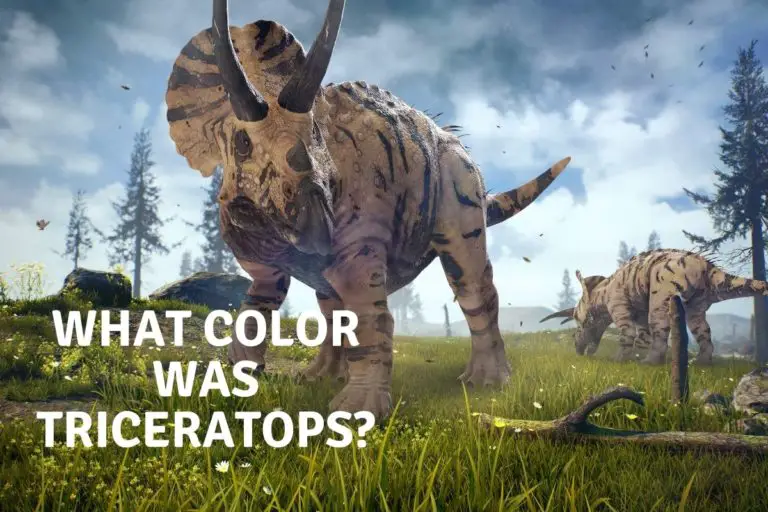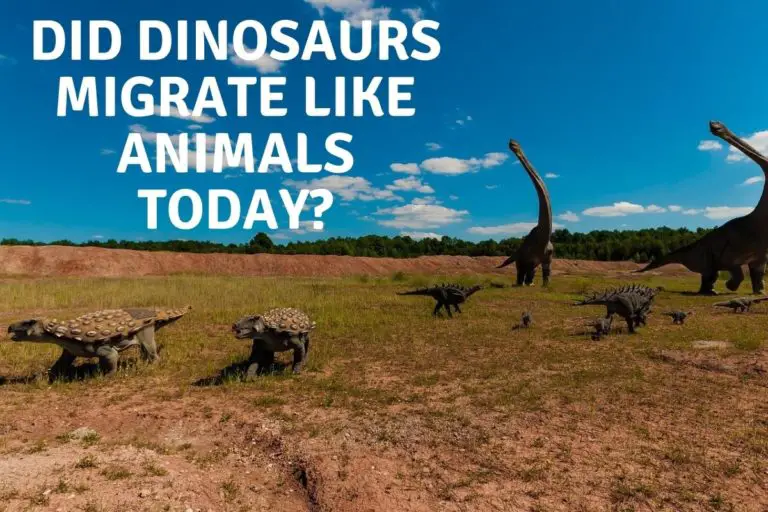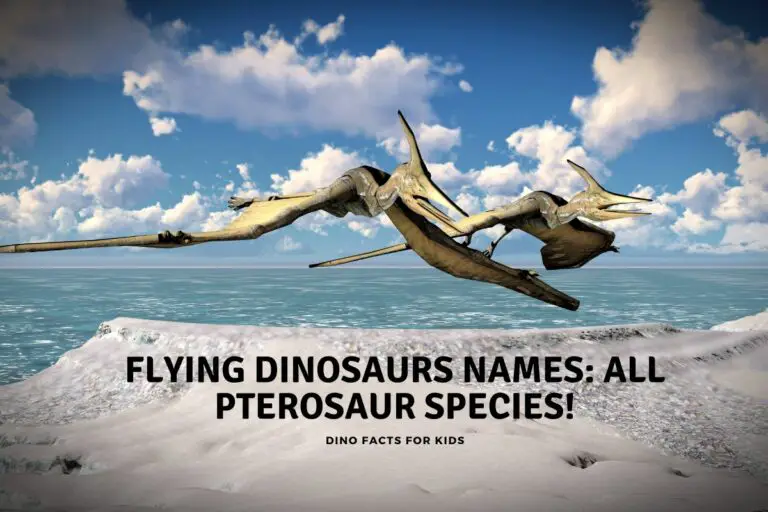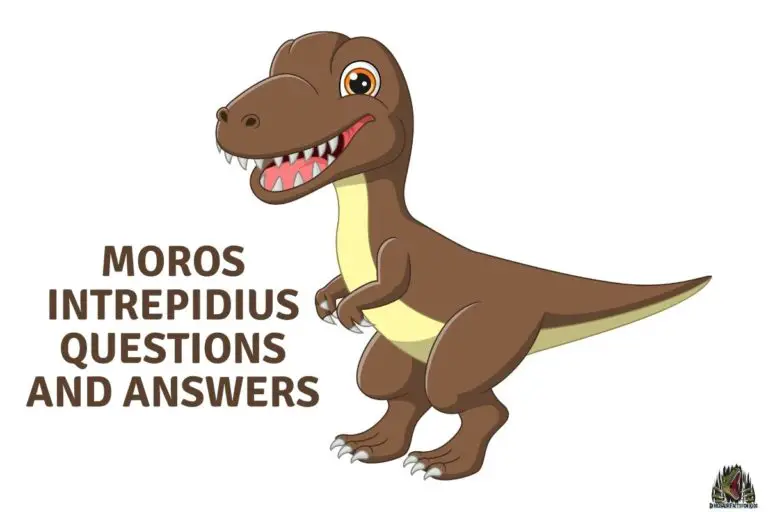What is the difference between a Giganotosaurus and a T-Rex
The largest carnivorous dinosaurs seemed to have very similar appearances. Huge jaws with long serrated teeth, powerful legs, and long tails, and two small arms of varying sizes. it could be difficult to tell them apart. So here we look at two of the most famous large carnivores, the Giganotosaurus and the Tyrannosaurus Rex (T-Rex).
T-Rex and Giganotosaurus were huge carnivorous dinosaurs lived in different periods. T-Rex, around 40 ft in length, weighed up to 9 tons and lived in North America 68 – 66 million years ago. Giganotosaurus, up to 43 ft in length and weighing around 8.2 tons, lived in South America 98-96 million years ago.
These huge dinosaurs ruled different at difference times of the Cretaceous period, each establishing itself as a dominant predator in its respective era.
Yet, despite their common portrayal as ferocious carnivores, the T-Rex and Giganotosaurus are more dissimilar than alike and lets get into that now.
The Giganotosaurus and the T-Rex
Understanding the differences between the Giganotosaurus and T-Rex involves exploring their physical characteristics, diets, behaviors, and roles in their respective ecosystems.
We take a look at them both below before comparing the two. You will see why there despite looking similar there were surprising differences between the two.
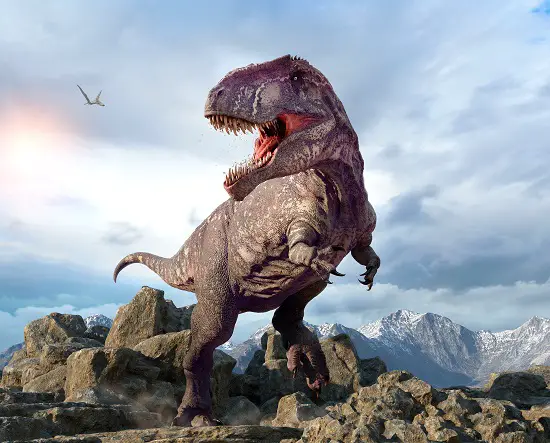
Overview of the Giganotosaurus
The Giganotosaurus, whose name means ‘giant southern lizard’, was a formidable carnivorous dinosaur that lived approximately 98 to 97 million years ago give or take a few million years during the Cretaceous period.
Fossils of this dinosaur have been discovered primarily in Argentina, indicating that it inhabited what is now South America.
The Giganotosaurus could reach lengths of up to 43 feet, making it one of the largest known terrestrial carnivores. Its physical characteristics were adapted for hunting larger prey. we have an article on the size of the Giganotosaurus here on the site.
With a slender, elongated skull equipped with sharp, serrated teeth, the Giganotosaurus was likely a formidable predator.
Its hind legs were robust and muscular, suggesting a capacity for swift pursuit, while its comparatively small forelimbs retained full functionality.
The Giganotosaurus’s diet primarily consisted of large herbivorous dinosaurs, evidenced by tooth marks found on fossilized bones of sauropods, whether it hunted juveniles or pack hunted adults is being researched.
This dinosaur’s behavior and role within the ecosystem was likely that of an apex predator, possibly hunting in groups. You can read more facts about a giganotosaurus here on the site.

Overview of the T-Rex
The Tyrannosaurus Rex (T-Rex), whose name translates to ‘tyrant lizard king’, lived approximately 68 to 66 million years ago during the late Cretaceous period.
Its fossils have been discovered across western North America, indicating a widespread range in this region.
The T-Rex was a colossal creature, with estimates suggesting it reached lengths of up to 40 feet and weighed as much as 9 tons.
Physically, the T-Rex was equipped with robust hind legs, a large skull, and tiny, but strong, forelimbs. Its jaw housed rows of serrated, banana-sized teeth, capable of crushing bone.
This dinosaur’s sensory capabilities were also highly developed, with binocular vision and a keen sense of smell.
The T-Rex was likely an apex predator, feeding on large herbivorous dinosaurs and possibly scavenging when opportunities arose.
Despite its fearsome reputation, recent studies suggest that T-Rex might have exhibited complex social behavior, including possible pack hunting and parenting.
We have more facts on the T-Rex here on the site as well.
Differences between the Giganotosaurus and T-Rex
Size Comparison
While both were massive creatures, the Giganotosaurus is thought to be slightly larger in terms of length, possibly reaching up to 43 feet.
In comparison, the T-Rex was generally about 40 feet long, but was more robust and weighed more, potentially reaching up to 9+ tons.
Physical Characteristics
The T-Rex had a larger skull, stronger jaws, and more substantial hind legs, while the Giganotosaurus had a more slender, elongated skull and full-functionality forelimbs. Both had sharp, serrated teeth designed for tearing flesh although the T-Rex Teeth were longer.
Dietary Habits
Both were carnivores and likely apex predators. The Giganotosaurus primarily hunted large herbivores, possibly in groups.
The T-Rex, on the other hand, preyed on large dinosaurs like hadrosaurus and ceratopsians ( among others) and may have also scavenged.
Behavior and Lifestyle
While currently speculative, there’s evidence that both dinosaurs could have hunted or lived in groups or family units.
T-Rex might have exhibited complex social behaviors such as parenting, while similar insights into the Giganotosaurus’s lifestyle are less clear but there is a school of thought that suggests if they were to prey on the large sauropods alive at the same time they may have needed help!
Living Period and Location
The Giganotosaurus lived during the mid-Cretaceous period (98-97 million years ago) in South America.
The T-Rex lived in a later era, the late Cretaceous period (68-66 million years ago), across western North America a difference of thousands of miles but more importantly over 30 million years apart. ( so that beginning scene of Jurassic Park Dominion was not in anyway accurate!)
Intelligence
Determining the intelligence of dinosaurs from fossil evidence is challenging.
However, while both T-Rex and Giganotosaurus are believed to have been highly adaptive and successful predators. The T-Rex is thought to be the smarter ( comparatively of the two) with a brain about twice the size of the giganotosaurus.
Speed
Estimates suggest the Giganotosaurus could potentially reach speeds of 20-31 mph and is thought to be faster than a T-Rex.
The T-Rex is estimated to have moved at a pace of 10-19 mph ( at an absolute maximum as weight and bone strength come under question at speeds higher than this)
These figures are generated through computer models and other indirect evidence and are still being studied.
Popularity
The T-Rex is certainly the more popular, often featuring prominently in movies, books, and exhibits. The Giganotosaurus, while less known, has been gaining recognition for its impressive size and predatory prowess
However bigger, longer, more scary or not it still has a long way to go to move the T-Rex from its most popular crown!
Table 1: Differences between T-Rex and Giganotosaurus.
| Aspect | Giganotosaurus | T-Rex |
|---|---|---|
| Size (Length) | Up to 43 feet | Up to 40 feet |
| Weight | Up to 8.2 tons | Up to 9 tons |
| Height at hips | Approximately 12-13 feet | Approximately 15 to 20 feet depending on posture. |
| Intelligence | Smaller Brain ( shaped like a banana it seems) | Larger brain and intelligent for a dinosaur. |
| Speed (Estimated) | 20-31 mph* | 10-19 mph* |
| Physical Characteristics | Slender skull, full-functionality forelimbs | Larger skull, stronger jaws, smaller forelimbs |
| Dietary Habits | Large herbivores | Large dinosaurs, possibly scavenged |
| Behavior and Lifestyle | Possibly group hunting | Complex social behaviors, possible group hunting |
| Living Period and Location | Mid-Cretaceous (98-97 MYA), South America | Late Cretaceous (68-66 MYA), North America |
| Popularity | Gaining recognition | Highly popular, widespread recognition |
Note: *The speed estimates are based on computer models and other forms of indirect evidence as direct measurements are not available. The figures are subject to scientific debate.
Discussion on Popular Misconceptions
Popular culture often romanticizes and simplifies dinosaur behavior, sometimes resulting in common misconceptions about these prehistoric creatures. We look at the three most common below.
1 . One such misunderstanding is that the Giganotosaurus and T-Rex existed at the same time and engaged in epic battles, which is untrue.
These species lived in different periods and geographical regions; the Giganotosaurus roamed South America during the mid-Cretaceous, while the T-Rex inhabited North America during the late Cretaceous.
2. Another widespread misbelief is that these dinosaurs were solitary hunters. While their exact social structures remain speculative, there’s growing evidence to suggest that both species could have engaged in pack hunting.
Particularly for the T-Rex, studies propose that they might have exhibited complex social behaviors, such as parenting and communicating.
3. The depiction of these dinosaurs’ physical attributes is often skewed as well. The T-Rex, for instance, is frequently mocked for its small forearms, despite them being extremely powerful and possibly used for clutching prey.
The Giganotosaurus, on the other hand, is often overlooked for its unique characteristics like its elongated skull and fully functional forelimbs, due to lesser media attention.
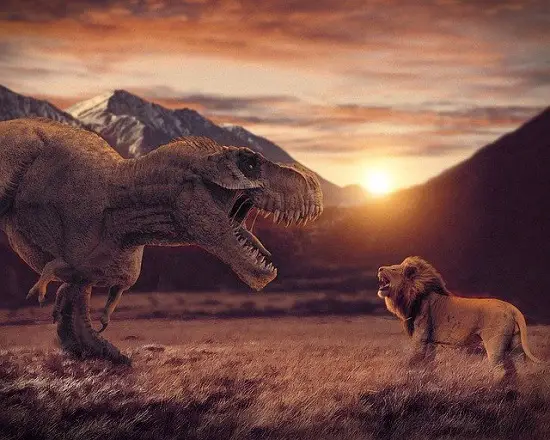
Who would win in a fight? Giganotosaurus vs. T-Rex.
The question of who would win in a battle between a Giganotosaurus and a T-Rex is a popular, speculative, topic often brought up by enthusiasts, made even more popular with just this fight happening in Jurassic World Dominion with a victorious T-Rex ( with some help from a therizinosaurus though)
Both were apex predators of their times, with massive bodies, powerful jaws, and fearsome reputations.
The Giganotosaurus, being slightly larger and potentially faster, would have had an advantage in terms of agility and reach. Its fully functional forelimbs could have been useful for grappling.
However, the T-Rex, while slightly smaller, was more robust with a heavier build. It boasted a larger skull, stronger jaws, and teeth designed for crushing bones, giving it superior biting power.
However, such a fight is purely speculative and not based on historical fact. Many factors would have come into play, such as the individuals’ health, age, experience, and possibly even their social groups.
The outcome would likely be determined by a combination of physical prowess, strategy, and circumstance.
Our money is always on a T-Rex though, a brain twice as large and those teeth!
Conclusion
Comparing the Giganotosaurus and T-Rex reveals more about their fascinating adaptations and roles in their respective ecosystems than determining a hypothetical ‘winner’ be in a fight or in who was the larger / more powerful.
Each of these massive predators was uniquely adapted to their environments and times and their presence was a vital part of their ecosystems.
So while there was plenty that was difference between a T-Rex and a Giganotosaurus, there was also plenty that was the same as well.
References
- https://a-z-animals.com/blog/giganotosaurus-vs-t-rex-who-would-win-in-a-fight/
- https://onlydinosaurs.com/giganotosaurus-vs-t-rex/
- https://www.diffen.com/difference/Giganotosaurus_vs_Tyrannosaurus
Hi, I am Roy Ford a General Studies and English Teacher who has taught all over the world. What started as a fossil collection became a great way to teach, motivate and inspire students of all ages and all over the world about dinosaurs and from that and children’s love of dinosaurs came the site dinosaur facts for kids, a resource for all ages.

